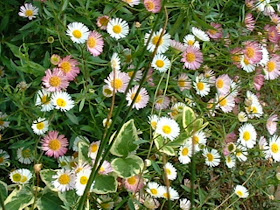Crawling among the cosmos, taller than me, next to the side of the road to try and get a good shot of these annual flowers was quite an experience. I almost fell in a rabbit hole, got black jacks all over my pants, walked straight through a huge Orb Web Spider’s web before I realised it and even disturbed a family of Partridges, who scared the daylights out of me as they all raucously took to the air!
Cosmos is a genus of about 20-26 species of annual and perennial plants in the famil Asteraceae, native to scrub and meadow areas in Mexico (where the bulk of the species occur), the southern United States (Arizona, Florida), Central America, South America, south toParaquay, and South Africa.
Cosmos in Mpumalanga, South Africa
They are herbaceous perennial plants growing 0.3-2 m tall. The leaves are simple, pinnate, or bipinnate, and arranged in opposite pairs.
White Cosmos in my garden
The flowers are produced in a capitulum with a ring of broad ray florets and a center of disc florets; flower color is very variable between the different species.
Cosmos next to a stream
Cosmos, along with many of our succulent and aloe species, have become regarded as indigenous in South Africa and bloom in various colours - white, pink, cerise and red - no yellow in South Africa. Having them in your garden ensures a wonderful display of colour during early autumn and summer.
It's against the law to pick the flowers next to the side of the road, but Cosmos seeds are now packaged and available at most nurseries. Growing them in the garden is easy and they make a wonderful country-style cut-flower arrangement.
Cosmos flowers is a favourite subject of, and has inspired, artists throughout the years and have been depicted on many a canvas.
Cosmos in my garden
::























































